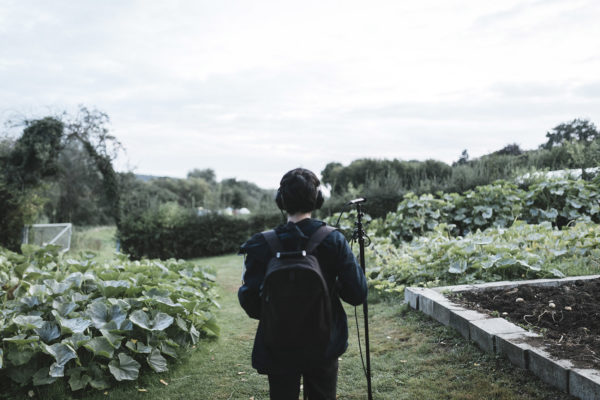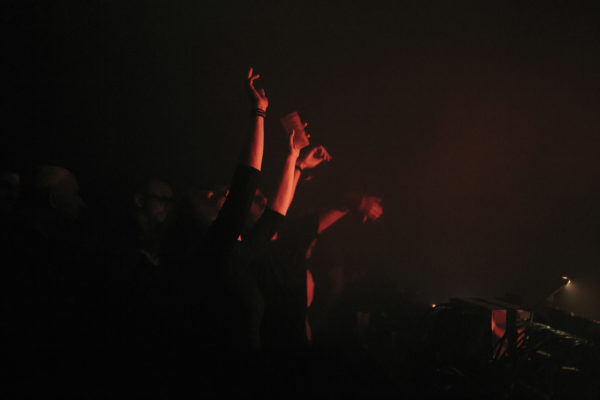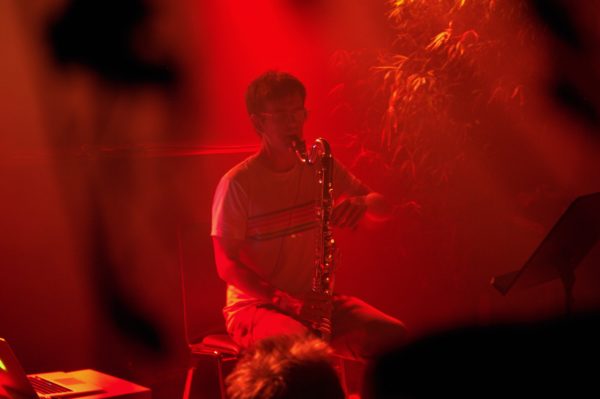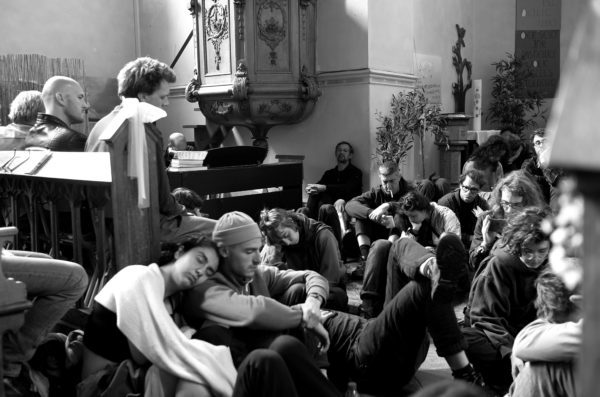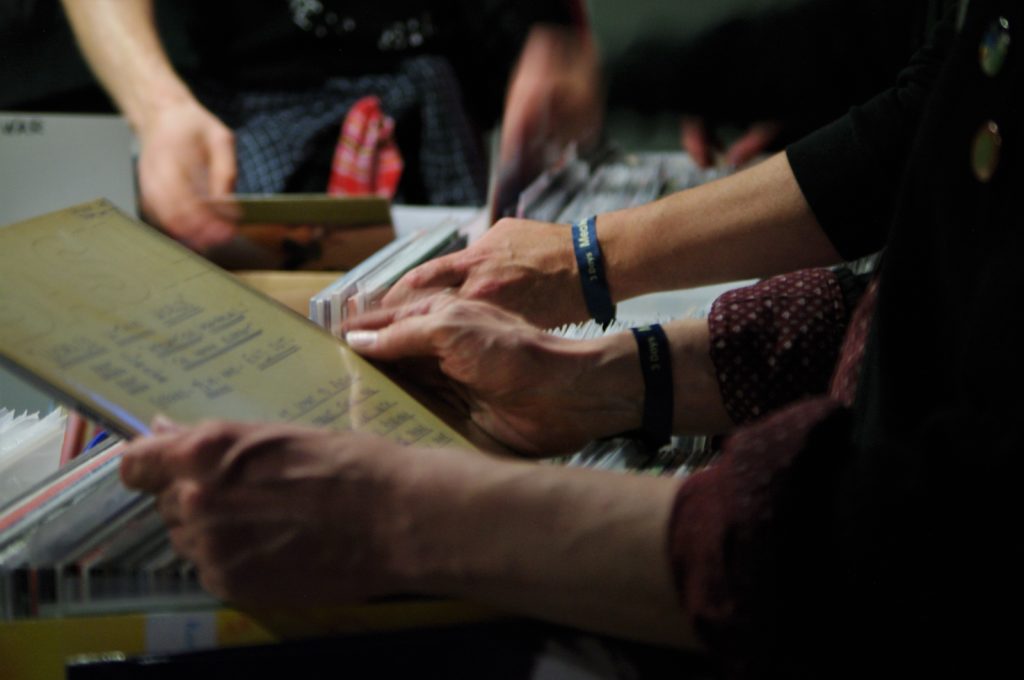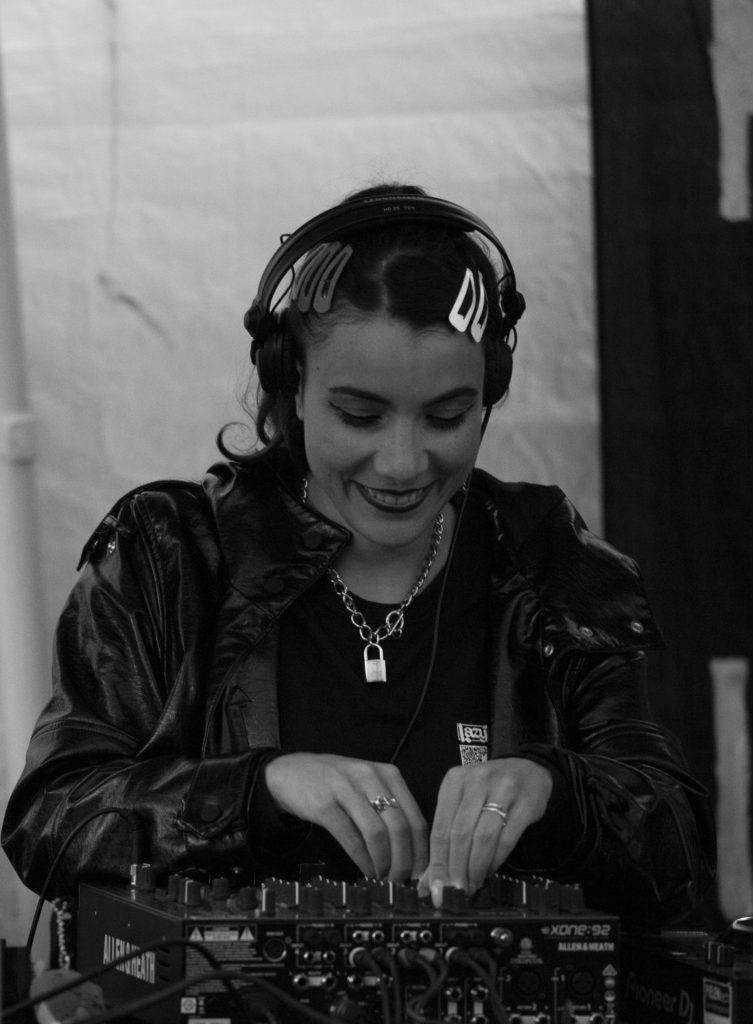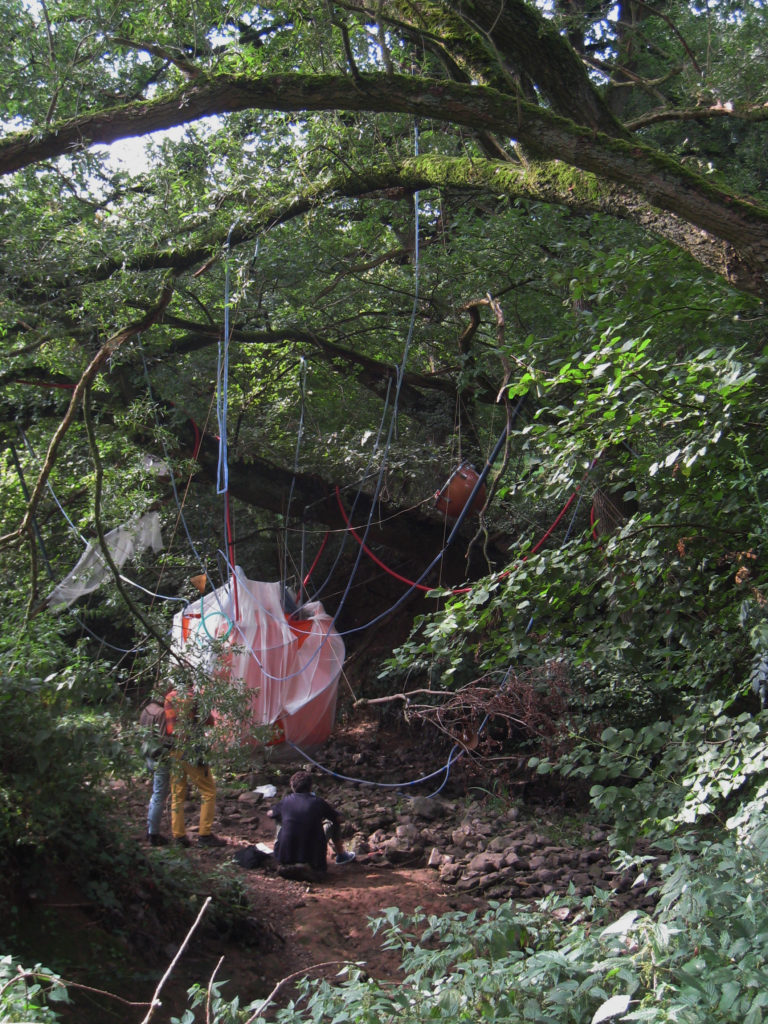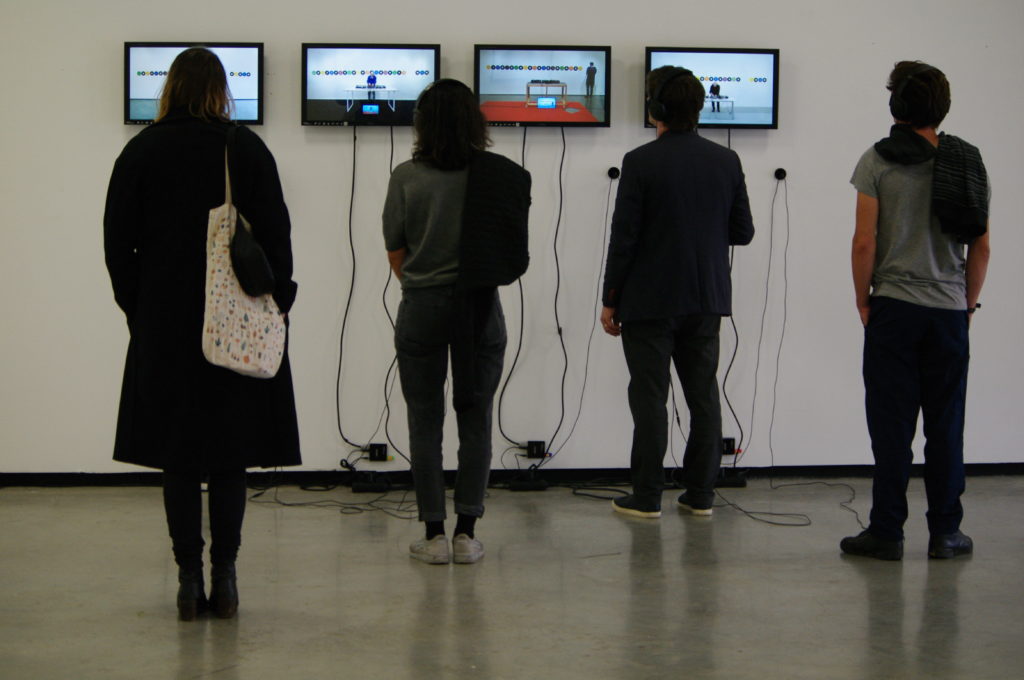“I’ll shit in his drum.”
It was a senior citizen who had uttered this peculiar threat while he was leaning on the green, wire-knitted fence that separated the street from his back garden. As is typical in these parts—the little town of Eupen in East Belgium, to be precise—he spoke neither French nor Flemish, but German in an accent reminiscent of the dialect spoken in the nearby Rhineland. It was late July and I had ended up in this particular street in Eupen together with Michael Kreitz and Christophe Houyon, who together with David Langela make up the team behind the various activities associated with the term Meakusma. We had met in order to discuss an audio reportage about the fourth edition of their festival to be held on the first weekend of September, which was also the reason they had brought me to this place—a narrow one-way street flanked by two smoothly plastered, windowless walls roughly five meters apart—to show me a particular sound.
About ten minutes before we arrived, Michael and Christophe had picked me up from the train station to take me to the various locations of the festival. There was a brief discussion in the car about where to start since Meakusma is held in a number of different spaces, including five different indoor venues as well as the street described above. Apparently, the latter produced a particular kind of echo, but I did not fully realize what they meant until Christophe clapped his hands.
Once. That was enough.
It’s notoriously difficult to describe unusual sounds without turning them into something they’re not, and the official term for this phenomenon—flutter echo—distorts what I heard that day. There was nothing light or airy about the echo; it was hard, metallic, and compressed.
“Like the fluttering of a moth’s wings, sound bounces back and forth rapidly between the two parallel walls to create a ‘zing,’ the illusion of a pitched note with a metallic quality.”
David Toop, Flutter Echo: Living within Sound
Usually, I’m only exposed to uncommon sounds in the context of consuming experimental music. There was something exhilarating about encountering such an extraordinary sound at the entrance to a seemingly ordinary suburban street where retirees lived quiet lives aside from the rare moments in which they threatened to shit in someone’s drum.
Why this threat? The echo, the man explained, apparently created a less fascinating sound inside the walls that produced it; their home, in other words. The tension dissipated slightly as we explained that we had not come with the intention to disturb anybody, but grew again when Michael and Christophe mentioned that, barring bad weather, a drummer was scheduled to play a thirty-minute concert in this location on a Saturday afternoon as part of the festival. The offer to have the couple shown around the Schlachthof during that time slot to introduce them to the festival and prevent them from having to put up with the concert fell on deaf ears. The conclusion of the argument:
“I’ll shit in his drum.”
I mention the anecdote only because it gives a good impression of some of the things Meakusma has to offer: new acoustic experiences, concerts in unconventional spaces, and experimental ways of playing well-known instruments (if none as radical as defecating in a drum and then playing it). Since it rained the Saturday of the festival weekend, the street concert with French percussionist Johann Mazé was cancelled, and nothing further came of this encounter. Even without it, attendees got to enjoy a range of incredible drumming: Mazé opened the Kühlraum on Friday, tapping, hitting, and mercilessly battering a range of metallic objects from cymbals to bowls and cones on a tom and snare, followed by the quartet Going playing kraut-inspired avant-rock with guitarists Tetuzi Akiyama and Manuel Mota. On Saturday evening, Mario Hänni, who drums for Hanreti and currently tours with Sophie Hunger, delivered a stand-out performance as part of Trio Heinz Herbert—one of two Swiss improvisational acts at Meakusma with Norbert Möslang [see zweikommasieben #11]. The Kühlraum was packed to the rafters for Eli Keszler’s performance on Sunday night, itself certainly a testament to Keszler’s ability to produce incredibly articulated sounds, no matter how loudly or quietly he plays, but also indicative of one of the issues Meakusma has been having as an indoor-festival. At a large outdoor event, you might find yourself at the back of the crowd with little to see, but at least you can’t get shut out of the room. With all three days sold out, signs appeared around the entrance area on the second day advertising the possibility to sell tickets back to the event for cash. I must admit that my weekend was not impacted by crowd numbers aside from Keszler’s performance, which I heard but did not see squeezed into a wall of people at the back of the Kühlraum, but this is an issue to be tackled for the festival’s fifth edition.
Directly above the Kühlraum, the Speicher, a cozy room with wooden floors and columns supporting a low ceiling, featured the festival’s quieter acts. Swedish-Finnish artist Marja Ahti opened the room late on Friday to a crowd sitting on couches, cushions, and on the floor, presenting pieces from her recent Vegetal Negatives [Hallow Ground, 2019], a fascinating exploration of the potential of non-human sounds. She was followed by the Belgian artist Lieven Martens performing as Lieven Martens Moana, who started of his set with a meandering and somewhat confusing speech about the history of Monserrate Palace in Portugal as an introduction to a new piece which I can only describe as baroque, featuring lavish, harpsichord-like sounds that dissolved into a melody of plucked strings all the more beautiful for its simplicity. After this unexpected turn, Martens played a more familiar sound, reminiscent of his work as Dolphins into the Future, before musician Philipp Dittmar and visual artist Sabrina Zeltner took the stage as Red On and Subrihanna. Live-A/V productions have become popular in recent years, with “live” frequently referring to the musical performance only. In this context, the German duo offered a fresher approach to live visuals produced by Zeltner using a syntheziser-interface to modulate projections in response to Dittmar’s looping of keyboard and guitar sequences.
In sharp contrast to the meditative ambient sounds of the Speicher and the live band sets and solo performances in the Kühlraum, the Halle, the largest space in the Schlachthof, featured a barrage of dance sets by Elena Colombi and Ben UFO as well as Brussels-based producer Sagat, underground mainstay John T. Gast, and personal favorite Parris [see zweikommasieben #19] on Friday. While Saturday still featured base-heavy thumping by the likes of Lee Gamble [see zweikommasieben #7], the concerts in the Halle continuously got quieter over the weekend, culminating in Arnold Dreyblatt’s performance of his Orchestra of Excited Strings project on Sunday night, for which chairs had been put out. Dreyblatt, who is famous for using modified instruments and his own system of tuning, spend the first ten minutes beating a rhythm into an upright base fitted with strings that produced a sharp metallic sound, creating a mesmerizing harmony of overtones. The Halle, in other words, offered a wide range of music, including Jochem Peteri aka NWAQ’s first live performance, presenting the results of a collaborative one-week residency in Eupen with Florian Meyer aka Don’t DJ [see zweikommasieben #13].
The same holds true for the programming of the Kesselraum, the final regular performance location in the Schlachthof building, in which audiences could hear anything from braindance to hip hop to ambient over the course of the weekend. On Saturday evening, Raz Mesinai aka Ghost Producer, astounded audiences with a set that led effortlessly from house to dancehall to illbient without appearing incongruous (as astounding as the technically less refined yet equally fascinating set by the Wino Wagon DJ-crew who did not just manage to squeeze LL Cool J and Steely Dan into the same set, but also made people dance to Struktur’s “A1”). The Kesselraum also featured Belgian musician Ben Bertrand, who last year released the wonderful ngc 1999 on les albums claus. Unfortunately, Bertrand’s performance fell victim to the layout of the Schlachthof. Bertrand’s concert coincided with the techno-heavy beginning of Colombi’s set in the adjacent Halle. The consistent base pounding in the background made it difficult to enjoy Bertrand’s soft bass clarinet melodies, which remained a problem even after Colombi was asked to turn down the volume a bit. This is of course an issue the organizers are aware of and the reason why, for example, no concerts are held in the Speicher unless the Kühlraum directly underneath it is not being used, yet it was not taken into account for Bertrand’s performance. Other performances in the Kesselraum were either sufficiently loud not to be impacted by the sound of other performances or programmed accordingly. The Italian duo Bellows, the project of Giuseppe Ielasi and Nicola Ratti, who slowly built up a calm submarine soundscape tethered to muted base lines and sonar beeps overlaid with fragmented steel drums and bells, was slotted in between the performances of Thomas Ankersmit and Eventuell.Duo next door. The Schlachthof, one must say, is not necessarily the optimal venue for a festival featuring music that should be enjoyed in a quiet setting. It is, however, convenient in that the proximity of everything makes it possible to program a huge array of artists and allows people to go from one stage to the other without having to plan in long walks. And the location also includes a hidden gem—the Turm—at which only one, but one of the most memorable performances of the weekend, was given by the duo Blurred Music.
The Turm, a little tower atop of the Schlachthof, can only be accessed by a narrow winding staircase that gives out into the middle of the small tower space, which in addition to Bulgarian violinist Biliana Voutchkova and German clarinetist Michael Thieke, who make up the Blurred Music project, only fits about twenty people. The name is programmatic as the two musicians improvise over pre-recorded material, sometimes in perfect parallel, then slowly fading out of sync, blurring the lines between live and recorded material. Voutchkova plucked and scraped away at her violin while Thieke huffed into and loudly suckled at his clarinet, with and without mouthpiece, creating a dense texture of sounds that visibly affected the audience. The intensity of Voutchkova and Thieke’s performance, which was not generated by overwhelming loudness or dissonance, but the brutal persistence of their playing coupled with the unusual way of using their instruments was compounded by the claustrophobic space that could not be left quietly since the entrance of the stairs was at Voutchkova’s feet. Their second performance at the IKOB, only a two-minute walk from the Schlachthof, seemed not to impact listener as much, a fact that can be attributed to the open gallery space which was much larger than the Turm and allowed people to casually stroll away from the back if they wanted to leave.
Given its various locations, Meakusma reinforces how spaces shape the reception of music. The open rooms of the IKOB, for example, worked well for acoustically dominant performances, such as that of the quartet Het Interstedelijk Harmoniumverbond, who were at the festival as part of a label showcase by Kraak, which also included performances by Floris Vanhoof and Jürgen De Blonde aka Köhn. Four harmoniums played at the same time produce a drone that is engrossing not because it is hypnotic but because it creates an aggressively expanding sonic landscape in which nothing but the minute internal changes within the acoustic layers can be heard. In a closed space, such music would be crushing. At the IKOB, it unfolded freely.
The four concerts in the church venues brought similar insights. Churches are great spaces for loud, harmonically complex sounds, such as those of a choir, or the simple, repetitive melodies of music associated with prayer and chanting. It did not come as a surprise, then, that the reverb-heavy, drawn-out distorted guitar chords of Liz Harris, most known for her work as Grouper, and Roy Montgomery worked much better in the high-vaulted ceiling of the large Nikolauskirche than the much more fragile sound of Tashi Wada, who performed with Julia Holter and Corey Fogel. Wada’s signature bag pipes and Holter’s gentle synth melodies tended to drown in the space, which, one should not forget, was originally built to put the fear of god into people. For this reason, the set worked best in places when organ and drums, accompanied by a persistent wailing sound reminiscent of a bomb siren, built up into a deafening and dissonant crescendo that could have announce the arrival of the dies irae. For this reason, Charlemagne Palestine might have suited the Nikolauskirche even more than the considerably smaller Friedenskirche. The platitude about maximal minimalism certainly applies to Palestine’s playing style, who performed a single 45-minute piece consisting of complex layerings of chords, and ended with him excitedly shouting “the organ is still the greatest synthesizer ever made.” While it would have been interesting to hear how such a sound would unfold in a larger space, Kali Malone [see zweikommasieben #19], who played before Palestine, was right at home in the more intimate space, presenting compositions from her latest album The Sacrificial Code [Ideal Recordings, 2019]. The slowly unfolding chord changes of Malone’s music seem to work better without the reverb of large spaces, which distracts from the precision of her playing.
As in previous years, The Heuboden, the only regular location not mentioned yet, the top floor in a building behind the Schlachthof, was taken over by the German branch of Dublab radio. The atmosphere in the room decked out with carpets, plants, and seating along the walls, generally was more relaxed than anywhere else, with people either kicking back to sets or dancing sedately even when there seemed to be cause for more frivolity. Céline Gillain, who released her album Bad Woman [Drama, 2018] to great critical acclaim last December, played with Lexi Disques founder Catherine Plevenaux, both wearing matching black jeans and white t-shirts that read “manic” and “depressive,” respectively (with each having the other word printed on the back of their shirts). Perhaps these words created the expectation that the performance forbade levity, and not even “West End Girls” seemed to be able to convince the crowd otherwise. Earnest listening continued. The Heuboden would present many other highlights, including Salon-Des-Amateur founder Detlef Weinrich aka Toulouse Low Trax [see zweikommasieben #15], Monika Werkstatt member Sonia Güttler, who releases music as Sonae, an all-tape set by mmodemm co-founder FM Aether [see zweikommasieben #17], and the above-mentioned DJs associated with the Dublin label Wino Wagon, to name only a few.
To name only a few: this review is necessarily partial since there simply was too much on at this year’s edition of Meakusma to cover the festival comprehensively. Altogether, there were over 100 acts, and I have not yet mentioned either the sound system put up on the lawn behind the Heuboden, where on Saturday 7FO & Tapes ushered in the afternoon with mellow reggae and Cera Khin kicked off the evening with breakbeats and a wobble base that pushed the system to the extreme, nor Fact’s “Against the Clock” lab (all sessions are available here), nor the host of additional activities and events on offer: public talks on the occasion of the publication of the second issue of Meakusma magazine, the self-performative audio guide by David Helbich commissioned for the first edition of the festival, art and sound installations, and shops by Cologne-based record store A-Musik and Berlin-based book store Zabriskie, on whose table I came across a book featuring the excerpt from David Toop’s memoir Flutter Echo: Living Within Sound quoted above. If the flutter echo brings me full circle, many more things remain to be said about, but only one will be mentioned here. Unlike many other festivals of this kind, Meakusma is not invested in overt political messaging. Rather than engaging in ideological discussions about the way experimental music and its disavowal of rigid definitions and distinctions fosters a sense of openness and tolerance, Meakusma’s politics are indirectly worked into the programming and ultimately left to the music—imagine Autechre’s “Flutter” without the liner notes. And this pays off. The festival’s vibe is relaxed and comfortable while the music provides countless moments of intensity and introspection. This is not to say that Meakusma does not have its problems, but there is no doubt that it ranks among the best contemporary festivals for experimental music, be it electronic or not.
